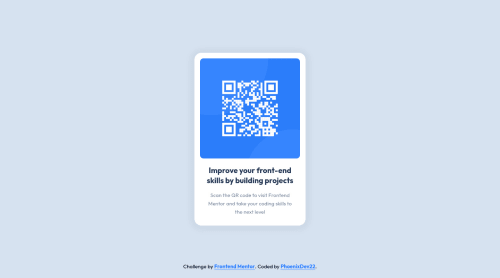QR code component HTML CSS JS

Solution retrospective
Hello community, I have completed another frontend mentor challenge. I learned a lot while making it .
-
I generated a QR code leading to my github page and added it to the back of the card (It's a flipped card ) .
-
I also used javascript for a flip function.
-
I prefered to use the svg for the QR code rather than an image , because it's much clearer.
-
I have some issues:
I set an explicit width and height to the card , if the remove the explicit width and height the card , all the elements would overlap. any suggestions to remove the explicit height and width without any issues?
I'd appreciate any comments for improvements or anything I've missed. Thank you in advance. Ps: The QR code is not valid anymore .
Please log in to post a comment
Log in with GitHubCommunity feedback
- @CornflakesPlus
Awesome flip, Phoniex! Although, I got a little scared looking at all that
<svg>tags in theindex.htmlfile. Is it that hard to make an SVG? How long did it take you? I'm intimidated I tell you. 😆 - @arthur11011
Great job @PhoenixDev22 , congratulations on completing the frontend mentor challenge! Using a QR code to link your GitHub page is a smart decision, very helpful as well to make your project more interactive and accessible.
In January I actually used a QR code in one of my projects in a very similar way. I created a digital portfolio with my web development work, and instead of listing my GitHub link, I included a QR code on the portfolio page. This QR would instantly take visitors to my CodePen page, allowing them to easily access my front-end web development projects. It's extremely user-friendly and adds a modern touch to your work:)
But I used another QR code generator, ViralQR. It proved to be a good one and worked without an issue, allowed me to create a dynamic QR code where I can change the information linked to QR code, very convenient! And makes me confident my code will still work in the long run.
What was your experience with the generator you used, do you think it has some advantages among others or did you just pick the first one you found? It will be great to hear your thoughts on the subject, thank you for sharing your experience with the community!
- @NaveenGumaste
Hay ! PhoenixDev22 Good Job on challenge
- @GitHub-dev12345
Congratulations 👍😊 complete your challenge,
Make your card looks very attractive used this code in your main card design css code
border-radius: 12px;
I hope you find this helpful
Join our Discord community
Join thousands of Frontend Mentor community members taking the challenges, sharing resources, helping each other, and chatting about all things front-end!
Join our Discord